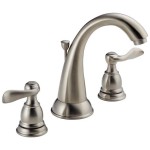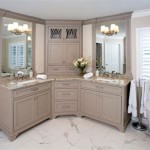Bathroom Vanity Top Right Side Sink: A Comprehensive Guide
The bathroom vanity is a critical element in any bathroom design, serving both functional and aesthetic purposes. The placement of the sink within the vanity top dictates the flow of movement within the bathroom and impacts the available countertop space. Opting for a right-side sink configuration offers specific advantages and disadvantages that deserve careful consideration. This article provides a comprehensive overview of bathroom vanity tops with right-side sinks, covering design considerations, material options, benefits, drawbacks, and installation tips.
A vanity top with a right-side sink is defined as a countertop where the sink basin is positioned towards the right side when facing the vanity. This configuration can be a strategic choice, particularly in bathrooms with specific spatial constraints or design preferences. The decision to place the sink on the right often centers on maximizing usable counter space, optimizing workflow, and catering to the user's handedness.
Understanding the nuances of right-side sink vanities is essential for homeowners, designers, and contractors alike. Careful planning and selection can result in a bathroom that is both functional and visually appealing. The following sections will delve into the key aspects of this design choice.
Design Considerations for Right-Side Sink Vanities
Designing a bathroom vanity with a right-side sink requires careful consideration of several factors. The overall size of the bathroom, the intended use of the vanity, and the user's preferences all play a crucial role in determining the optimal design.
One of the primary considerations is the available space. In smaller bathrooms, a right-side sink can free up valuable counter space on the left side, which can be used for toiletries, accessories, or even decorative items. This is especially beneficial if the bathroom is used by multiple people, as it provides more individual space for each user.
The position of the plumbing is another important factor. While it is possible to relocate plumbing, doing so can be costly and time-consuming. Ideally, the vanity should be positioned in a way that minimizes the need for extensive plumbing modifications. A right-side sink might be a natural fit if the existing plumbing is already located on the right side of the wall.
The user's handedness should also be taken into account. For right-handed individuals, a right-side sink might feel more natural and convenient, allowing for easy access to the sink and adjacent counter space. Conversely, left-handed individuals might prefer a left-side sink. However, this is largely a matter of personal preference, and many people adapt easily to either configuration.
The overall aesthetic of the bathroom should also be considered. The placement of the sink can affect the balance and symmetry of the design. For example, if the vanity is positioned next to a wall on the right side, a right-side sink might create a more balanced and visually appealing look. Conversely, if the vanity is positioned next to a wall on the left side, a left-side sink might be a better choice.
Finally, the type of sink should be considered. There are several types of sinks that can be used with a right-side vanity, including undermount sinks, drop-in sinks, vessel sinks, and integrated sinks. Each type of sink has its own advantages and disadvantages, and the choice will depend on the user's preferences and the overall design of the bathroom.
Material Options for Right-Side Sink Vanity Tops
The material chosen for the vanity top significantly impacts the bathroom's aesthetics, durability, and maintenance requirements. Several options are available, each with unique properties and price points.
Granite is a popular choice for vanity tops due to its durability, heat resistance, and natural beauty. It's available in a wide range of colors and patterns, making it a versatile option for various bathroom styles. Granite is a porous material, however, and requires sealing to prevent staining. Regular sealing is essential to maintain its appearance and prevent damage.
Quartz is an engineered stone composed of quartz crystals and resin. It offers excellent durability, stain resistance, and low maintenance requirements. Quartz is available in a wide range of colors and patterns, including options that mimic the look of natural stone. Unlike granite, quartz does not require sealing, making it a more convenient option for busy homeowners.
Marble is a luxurious and elegant choice for vanity tops. It's known for its distinctive veining and smooth texture. However, marble is a softer stone than granite or quartz and is more susceptible to scratching and staining. It also requires regular sealing. While marble offers a sophisticated aesthetic, its higher maintenance requirements should be considered.
Solid Surface materials, such as Corian, are non-porous and seamless, making them highly resistant to stains and bacteria. They can be molded into various shapes and sizes, offering design flexibility. Solid surface materials are also relatively easy to repair if damaged. However, they are generally less heat resistant than granite or quartz.
Laminate is a cost-effective option for vanity tops. It consists of a thin layer of decorative paper bonded to a particleboard core. Laminate is available in a wide range of colors and patterns and is relatively easy to clean. However, it's less durable than other materials and is susceptible to water damage if the edges are not properly sealed.
Wood vanity tops, often sealed with a waterproof coating, provide a warm and natural aesthetic. These can be made from various wood species, each offering a unique grain and color. Proper sealing is crucial to prevent water damage and warping. Regular maintenance, including re-sealing, is necessary to prolong the life of a wood vanity top.
The choice of material will depend on the user's budget, style preferences, and maintenance expectations. Carefully weighing the pros and cons of each material is essential for making an informed decision.
Benefits and Drawbacks of Right-Side Sink Vanities
Choosing a right-side sink vanity offers specific advantages while also presenting certain drawbacks. A thorough understanding of these aspects is crucial for informed decision-making.
Benefits:
One of the primary benefits of a right-side sink vanity is the maximization of countertop space. By positioning the sink on the right, the remaining counter space on the left becomes more usable for toiletries, makeup, or other bathroom essentials. This is especially helpful in smaller bathrooms where counter space is limited.
Another benefit is the potential for improved workflow. For right-handed individuals, a right-side sink can feel more natural and convenient, allowing for easy access to the sink and adjacent counter space. This can streamline the morning routine and make it easier to perform tasks such as washing hands, brushing teeth, or applying makeup.
Right-side sink vanities can also offer aesthetic advantages. Depending on the layout of the bathroom, a right-side sink might create a more balanced and symmetrical look. This is particularly true if the vanity is positioned next to a wall on the right side, as it can help to visually anchor the vanity and create a sense of harmony.
Finally, right-side sink vanities can be a practical choice if the existing plumbing is located on the right side of the wall. This can minimize the need for extensive plumbing modifications, saving time and money on installation costs.
Drawbacks:
One of the potential drawbacks of a right-side sink vanity is that it might not be ideal for left-handed individuals. A left-side sink might feel more natural and convenient for left-handed users. However, many people adapt easily to either configuration.
Another potential drawback is that a right-side sink might not be suitable for all bathroom layouts. If the vanity is positioned next to a wall on the left side, a right-side sink might create a visually unbalanced look. In such cases, a left-side sink might be a better choice. Furthermore, if there are any obstructions on the left side, like a toilet or wall, it can make the countertop space on the left less usable.
Finally, depending on the size of the vanity and sink, a right-side sink might leave a relatively small amount of counter space on the left side. While this might be sufficient for some users, others might prefer a larger counter space area. Careful measurement and planning are essential to ensure that the chosen configuration meets the user's needs.
Careful consideration of these benefits and drawbacks is essential for determining whether a right-side sink vanity is the right choice for a particular bathroom. Evaluating the user's handedness, the bathroom layout, and the desired amount of counter space is crucial for making an informed decision.

The Marble Factory Bathroom Vanity Top Right Hand Sink 37 In X 22 White Engineered Réno Dépôt

Bellaterra Home Vista 48 In W X 22 D 36 H Single Vanity Natural With Marble Top White Right Basin 6001r Nl Jw The Depot

Bellaterra Home 37 In W X 22 D 2 H White Quartz Vanity Top With Right Side Oval Sink Bt4301 37r Weo The Depot

Concrete Vanity Top With Integral Sink What We Make

The Marble Factory 49 In X 22 Bathroom Vanity Top With Integral Sink Solid Bone Rona

Bellaterra Home 37 X 22 White Quartz Three Hole Vanity Top With Righ Us Bath

Dyconn True 63 In W Solid Surface Vessel Vanity Top Matt White With Basin Ssvt60 The Home Depot

38 Inch Espresso Single Sink Bathroom Vanity White Marble

The Marble Factory 49 In X 22 Bathroom Vanity Top With Integral Sink Willow Mist Réno Dépôt

Bellaterra Home 48 In W X 22 D 36 H Single Vanity Rustic Wood With Jazz White Marble Top Right Side Basin 6001r Rw Jw The Depot
Related Posts







